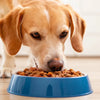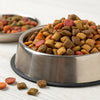How Much Raw Dog Food to Feed My Dog: A Comprehensive Guide for Pet Parents
- Houndsy
Table of Contents
- Introduction
- Understanding Your Dog's Nutritional Needs
- Calculating Portion Sizes for Raw Dog Food
- Tips for Transitioning to a Raw Food Diet
- Exploring Common Concerns and FAQs
- Conclusion
Introduction
Did you know that the dietary needs of your dog can change dramatically over their lifespan? According to recent studies, nearly 50% of dogs in the U.S. are considered overweight or obese, which can lead to serious health issues like diabetes and joint problems. As devoted pet owners, we want to provide the best life for our furry friends, and that starts with understanding what to feed them and how much.
In this blog post, we will explore the ins and outs of raw dog food diets, including how much raw dog food to feed your beloved pup based on various factors such as their weight, activity level, and age. As we navigate through this topic, we will also emphasize the importance of choosing high-quality food and how Houndsy can elevate your dog-feeding experience with our innovative Kibble Dispenser, ensuring that consistency and convenience accompany great nutrition.
By the end of this article, you'll have a clear understanding of how to tailor your dog’s raw food diet to meet their specific needs while ensuring that the process remains enjoyable. We will cover the following aspects:
- Understanding your dog's nutritional needs
- Calculating the right portion sizes for various breeds and ages
- Tips for transitioning to a raw food diet
- Exploring common concerns and FAQs regarding raw feeding
Let’s jump in and simplify the task of feeding your best friend!
Understanding Your Dog's Nutritional Needs
Before we dive into the specifics of how much raw dog food to feed your dog, it’s essential to understand the fundamental nutritional needs of dogs. Dogs are omnivores, but their diet usually needs to be higher in protein for optimal health, particularly when consuming raw foods.
Macros and Nutrients for Dogs
- Proteins: Raw dog food typically includes high levels of proteins derived from meats, such as chicken, beef, or fish, which are crucial for muscle development and overall health.
- Fats: Healthy fats from animal sources are vital for energy and supporting skin and coat health.
- Carbohydrates: While not as prominent in a raw diet, certain fruits and vegetables can provide necessary vitamins and minerals.
- Vitamins and Minerals: Bones and organ meats are great sources of essential vitamins and minerals.
Knowing the right balance of these nutrients is key to ensuring that your raw dog food diet is beneficial. Always remember that different factors will influence your dog’s dietary needs.
Factors That Affect Portion Sizes
Factors that affect how much raw dog food to feed your dog include:
- Weight: An average guideline is about 2-4% of your dog’s ideal body weight for adult dogs.
- Age: Puppies will typically require more food—about 4-6% of their body weight—due to their growth and energy requirements.
- Activity Level: Highly active dogs will require more food than less active ones.
By understanding these fundamental aspects, we can make educated decisions about how much food our dog needs.
Calculating Portion Sizes for Raw Dog Food
To determine how much raw dog food to feed your dog, we can use a general formula based on weight, age, and activity levels. Let’s break it down step by step.
For Adult Dogs
A common guideline is to feed your adult dog 2-4% of their body weight daily in raw food. Here's how it works for different weight brackets:
- Over 100 lbs: If you have a large dog weighing 100 lbs, you would offer approximately 2 to 3 lbs of raw food daily.
- 50-100 lbs: For medium to large dogs, the recommended portion is about 1-2 lbs per 50 lbs of body weight. So for a 75 lb dog, you might provide around 1.5 to 2 lbs of food.
- 20-50 lbs: For smaller dogs weighing around 25 lbs, you would feed around 0.5-1 lb per day.
- Under 20 lbs: Smaller breeds and those under 10 lbs often require more calories on a per-pound basis. For a 10 lb dog, typically around 0.2-0.5 lbs daily is sufficient.
Examples Based on Weight
Here are daily feeding amounts based on weights to provide a clearer picture:
- 10 lbs dog: 0.2 - 0.5 lbs per day (roughly 3.2 - 8 oz)
- 25 lbs dog: 0.5 - 1 lb per day (roughly 8 - 12 oz)
- 50 lbs dog: 1 - 1.5 lbs per day (roughly 16 - 24 oz)
- 75 lbs dog: 1.5 - 2.3 lbs per day (roughly 25 - 37 oz)
For Puppies
Puppies have different requirements because they are growing rapidly, and they typically need more frequent, smaller meals:
- Age 0-3 months: Puppies should be fed 4 meals a day. Quantity can vary widely (approximately 8-10% of body weight).
- Age 3-6 months: Start feeding 3 meals a day, and around 6-8% of their body weight.
- Age 6-12 months: Move to 2-3 meals a day with about 4-6% of their body weight daily.
For instance, a 20 lb puppy might consume approximately 1 - 1.5 lbs of food daily.
Tips for Transitioning to a Raw Food Diet
Switching to a raw food diet can be a significant change for both you and your dog. Here are practical steps for a smoother transition:
1. Gradual Introduction
Start by introducing raw food in small amounts mixed with their current food. Gradually increase the portion of raw food while decreasing their previous diet over a week or two to avoid digestive upset.
2. Monitor Your Dog's Reaction
Keep an eye on your dog’s digestion and behavior during the transition. At first, you may notice variations in stools as their digestive system adapts. It’s normal, but if you see extreme changes such as vomiting or persistent diarrhea, consult your veterinarian.
3. Provide a Balanced Diet
Ensure you're not only sticking to meat. Include bones for calcium, organ meats for vitamins, and occasional vegetables or fruits.
Exploring Common Concerns and FAQs
Are Raw Diets Safe for Dogs?
While many pet parents have reported health benefits when switching to a raw diet, it’s crucial to ensure that the food is handled safely to prevent contamination. Bacteria in raw meat can pose a risk to both pets and humans, so always wash your hands and surfaces after handling raw food.
Can Raw Diets Lead to Nutritional Imbalances?
This concern is valid as feeding unbalanced raw diets, or feeding the same protein continuously can cause deficiencies. Always aim for a variety of protein sources, and consider consulting a veterinarian or a pet nutritionist to ensure nutritional adequacy.
What Signs Indicate the Right Portion Size?
A healthy weight, good energy levels, and firm stools are indicators that your dog is getting the right amount of food. Adjust portions according to any weight changes, and remember that each dog is unique.
How Do I Use Houndsy’s Kibble Dispenser for Raw Food?
At Houndsy, we’ve designed our flagship product, the Houndsy Kibble Dispenser, to enhance your dog-feeding experience. Featuring ergonomic convenience and stylish mid-century modern design, our dispenser makes it easy to measure out those perfect portions, ensuring each feeding is efficient, consistent, and pleasing to the eye.
Conclusion
Feeding your dog the proper amount of raw food isn’t just about sticking to percentages—it's about understanding your individual dog’s needs and maintaining their health. By calculating the right portions, transitioning smoothly, and observing their responses, we can ensure our furry friends lead happy and healthy lives.
As you navigate through this process, we hope you remember our commitment at Houndsy—to simplify and elevate pet care with innovative designs that make feeding a joyful experience. Interested in reimagining your dog-feeding routine? Explore the benefits of using the Houndsy Kibble Dispenser and find the perfect blend of convenience and style for your home today!
FAQ
Q: How often should I feed my dog raw food?
A: Adult dogs generally do well with two meals a day, while puppies may need three to four depending on their age.
Q: What if my dog is picky about raw food?
A: Mixing in some of their favorite cooked food or warmed meat may entice them to eat. Always introduce new foods gradually.
Q: Is it necessary to supplement with anything else?
A: Depending on the balance of your raw diet, you may need to consider adding supplements like fish oil for omega-3 fatty acids, but always consult with a vet.
Q: Can I continue to mix raw food with kibble?
A: While some owners do this for convenience, mixing raw and kibble can lead to digestive issues for some dogs. It's best to feed them separately.
Feel empowered to take control of your dog’s diet and enjoy the shared feeding moments that come with it!













